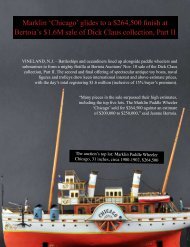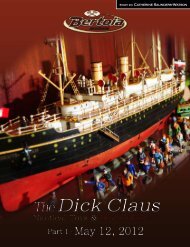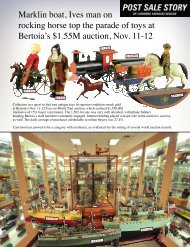Early Transportation Toys: On the Move - Bertoia Auctions
Early Transportation Toys: On the Move - Bertoia Auctions
Early Transportation Toys: On the Move - Bertoia Auctions
Create successful ePaper yourself
Turn your PDF publications into a flip-book with our unique Google optimized e-Paper software.
especially at <strong>the</strong> top end. According to Dale Kelley, who founded <strong>the</strong> Chicago Toy Show in 1974 and has been running it ever since,<br />
you could buy any Buddy “L” pressed-steel truck in <strong>the</strong> show for $25 that first year. When Kelley sold a mint 24-inch, Buddy “L” Red<br />
Baby pickup truck in 1976 for $400, it was <strong>the</strong> biggest price ever for a Buddy. When that same Red Baby emerged on <strong>the</strong> market again<br />
in 1999, it soared to $22,000. (A 5400% appreciation over 23 years? Not bad!) Collector Bob Brady spent $4,500 to acquire a pristine<br />
1928 Hubley cast-iron Harley-Davidson Parcel Post motorcycle with a hinged rear door and <strong>the</strong> original wood-beaded pull string in <strong>the</strong><br />
mid 1980s; he sold it last year for $30,000.<br />
<strong>On</strong>e accelerant to <strong>the</strong> markets over <strong>the</strong> last ten years? The emergence of several long-held collections. In 2001 alone, three monster<br />
sales unleashed a torrent of quality material, from <strong>the</strong> F.H. Griffith and Covert Hegarty auctions of cast-iron gems to <strong>the</strong> long-awaited<br />
dispersal of <strong>the</strong> Buddy “L” company archive of toys, samples and prototypes at Randy Inman <strong>Auctions</strong>. In 2005 <strong>the</strong> Bob Brady and Bob<br />
and Jackie Stewart collections brought even more top-notch cast-iron material to light.<br />
The flip side of that trend is that <strong>the</strong> collector pool for this material is generally graying, with only a recent infusion of younger blood. So<br />
as some collectors cash out, and o<strong>the</strong>rs fill holes in <strong>the</strong>ir collections, competition at <strong>the</strong> top can get skimpy.<br />
Meanwhile, at <strong>the</strong> lower end of <strong>the</strong> market, eBay has done a good job in helping to define <strong>the</strong> universe of what’s common. Says Dan<br />
Morphy of Morphy <strong>Auctions</strong>, “An Arcade cast-iron taxi in really nice condition that brought $7,000 to $10,000 ten years ago will sell<br />
between $4,000 to $5,000 today because more have turned up.” The site has also brought in a lot of new collectors. Most tend to start<br />
with material <strong>the</strong>y played with or wanted as a kid. Then, as <strong>the</strong>ir eye and taste begin to refine, <strong>the</strong>y often come to appreciate <strong>the</strong><br />
craftsmanship and charm of <strong>the</strong> older pieces and move to live auctions.<br />
What brings value in prewar transportation toys? Above all, condition and desirability. Rarity counts, but if a toy doesn’t set hearts athumping,<br />
it doesn’t matter how rare it is. To understand what <strong>the</strong> market prizes, we only need look at <strong>the</strong> two top-priced items in <strong>the</strong><br />
past few years: a “Say it with Flowers” motorcycle van (see above) that fetched $126,750 in 2001 and a 1880s Carpenter cast-iron<br />
horse-drawn Tally Ho. Both were rare, large examples of <strong>the</strong>ir form. Both were completely original, unrestored, with vibrant paint, in<br />
never-played-with condition. Both came from significant private collections.<br />
Size definitely makes a difference in value. Many companies issues certain vehicles in a range of sizes and luxury options. Maybe<br />
because <strong>the</strong>y were more likely to have been played with outside and suffered more from <strong>the</strong> elements, larger examples tend to be<br />
scarcer. A mint David’s moving van, for example, can sell for $4,000 to $5,000, while one three times <strong>the</strong> size would bring $25,000.<br />
And how is condition assessed? Significant condition problems can drop <strong>the</strong> price by 50%, says Rich <strong>Bertoia</strong> of <strong>Bertoia</strong> <strong>Auctions</strong>. For<br />
<strong>the</strong> most part, restoration is frowned on, especially a wholesale repainting of something that had mostly original paint to begin with.<br />
Connoisseurs prefer honest playwear to a shiny-new restored surface. But, says cast-iron collector, restorer and dealer Russ<br />
Harrington, <strong>the</strong> rarer and valuable <strong>the</strong> toy, <strong>the</strong> more it can withstand <strong>the</strong> scourge of being restored and having substitute parts. Many of<br />
<strong>the</strong>se toys came with separate accessories—from drivers and passengers to fire hoses and buckets. Leila Dunbar of So<strong>the</strong>by’s cites<br />
<strong>the</strong> example of a Hubley cast-iron Indian sidecar motorcycle that sold for $20,300. <strong>On</strong>e of <strong>the</strong> reasons it commanded a premium: it had<br />
all of its original civilian figures. If <strong>the</strong> figures had been replaced, it would’ve sold closer to $6,000, she speculates. And because most<br />
Hubley figures were police figures, <strong>the</strong>y are <strong>the</strong> most common replacements. Had police figures been substituted, she estimates that<br />
<strong>the</strong> value would’ve dropped to $3,500.<br />
Original boxes can also add punch to a price: up to 30% or more, depending on <strong>the</strong>ir age, rarity and design. Boxes for early cast-iron<br />
cars were often non-descript, while those for German lithographed tin toys could often fairly elaborately decorated.<br />
Herein, a quick rundown of <strong>the</strong> markets for prewar cast-iron, tin and pressed steel toys.<br />
This 1925 27-inch Buddy “L” Insurance Patrol truck<br />
smashed all records for pressed steel cars at<br />
$40,700. Why? It’s <strong>the</strong> only known example, it came<br />
with its original box and it hailed from <strong>the</strong><br />
company’s own historic archive.<br />
Cast-iron transportation toys: Cast-iron horse-drawn vehicles appeared on <strong>the</strong> American toy scene starting in <strong>the</strong> last quarter of <strong>the</strong><br />
19th century. Ranging from buggies, brakes and cabriolets to fire hose reels and circus wagons, <strong>the</strong>y are <strong>the</strong> oldest, rarest and most<br />
thoroughly handcrafted of <strong>the</strong> three categories. While parts were made with steel patterns, <strong>the</strong>y were hand assembled and painted.<br />
Important makers include Carpenter, Hubley, Ives, and Welker & Crosby, among o<strong>the</strong>rs.<br />
Compared to <strong>the</strong> go-go market for cast-iron mechanical banks, which regularly reaches into six figures for <strong>the</strong> best examples, cast-iron<br />
horse-drawn toys are still relatively undervalued, asserts John Olshefski, a California-based collector whose reference guide on <strong>the</strong><br />
subject is due out this winter. You can build a top-notch collection, he contends, without spending any more than $3,000 to $10,000 per<br />
piece. <strong>On</strong>ly a handful of pieces sell in <strong>the</strong> mid or high five figures. The Holy grail of horse-drawn? The Carpenter Tally Ho coach, a<br />
complex rig with four horses, a driver, and six splendidly dressed passengers sitting atop a midnight blue coach with red-spoked<br />
wheels. It has sold between $20,000 and $92,000 in <strong>the</strong> last few years, depending on condition.






